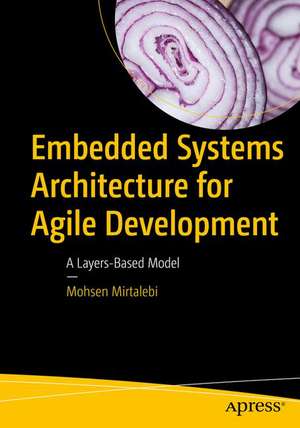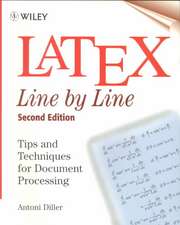Embedded Systems Architecture for Agile Development: A Layers-Based Model
Autor Mohsen Mirtalebien Limba Engleză Paperback – 25 oct 2017
Utilize a new layers-based development model for embedded systems using Agile techniques for software architecture and management. Firmware is comprised of both hardware and software, but the applicability of Agile in embedded systems development is new. This book provides a step-by-step process showing how this is possible.
The book details how the moving parts in embedded systems development affect one another and shows how to properly use both engineering tools and new tools and methods to reduce waste, rework, and product time-to-market. Software is seen not as a commodity but a conduit to facilitate valuable product knowledge flow across the company into the hands of the customer.
Embedded Systems Architecture for Agile Development starts off by reviewing the Layers model used in other engineering disciplines, as well as its advantages and applicability to embedded systems development. It outlines development models from project-based methodologies (e.g., collaborative product development) to the newer modern development visions (e.g., Agile) in software and various tools and methods that can help with a Layers model implementation. The book covers requirement modeling for embedded systems (Hatley-Pirbhai Method) and how adapting the HP Method with the help of the tools discussed in this book can be seen as a practical example for a complete embedded system.
- Identify the major software parts involved in building a typical modern firmware
- Assign a layer to each software part so each layer can be separate from another and there won’t be interdependencies between them
- Systematically and logically create these layers based on the customer requirements
- Use Model-Based Design (MBD) to create an active system architecture that is more accepting of changes
Who This Book Is For
Firmware engineers; systems architects; hardware and software managers, developers, designers, and architects; program managers; project managers; Agile practitioners; and manufacturing engineers and managers. The secondary audience includes research engineers and managers, and engineering and manufacturing managers.
Firmware engineers; systems architects; hardware and software managers, developers, designers, and architects; program managers; project managers; Agile practitioners; and manufacturing engineers and managers. The secondary audience includes research engineers and managers, and engineering and manufacturing managers.
Preț: 214.88 lei
Preț vechi: 268.60 lei
-20% Nou
Puncte Express: 322
Preț estimativ în valută:
41.12€ • 42.77$ • 33.95£
41.12€ • 42.77$ • 33.95£
Carte disponibilă
Livrare economică 24 martie-07 aprilie
Preluare comenzi: 021 569.72.76
Specificații
ISBN-13: 9781484230503
ISBN-10: 1484230507
Pagini: 213
Ilustrații: XVIII, 213 p. 99 illus., 59 illus. in color.
Dimensiuni: 178 x 254 mm
Greutate: 0.42 kg
Ediția:1st ed.
Editura: Apress
Colecția Apress
Locul publicării:Berkeley, CA, United States
ISBN-10: 1484230507
Pagini: 213
Ilustrații: XVIII, 213 p. 99 illus., 59 illus. in color.
Dimensiuni: 178 x 254 mm
Greutate: 0.42 kg
Ediția:1st ed.
Editura: Apress
Colecția Apress
Locul publicării:Berkeley, CA, United States
Cuprins
Chapter 1: The History of Layers Architecture.- Chapter 2: Project Management Methods.- Chapter 3: Convergence of Management and Architecture.- Chapter 4: Requirements Model.- Chapter 5: Problem Statement.- Chapter 6: Major Component of Real-Time System Development.- Chapter 7: What is a Model?.- Chapter 8: MBD and Requirements Model.
Notă biografică
Mohsen Mirtalebi is a specialist in diagnostics software with Cummins Inc., a global power leader that designs, manufactures, sells, and services diesel and alternative fuel engines as well as related components and technologies. He has more than 10 years of experience in the engineering field. At Cummins, Mohsen leads a team of engineers, where he oversees the software quality meeting regulatory requirements by utilizing various data analysis tools, control software reviews, as well as Agile and project management tools. Previously he worked for Rockwell automation as a control firmware engineer, responsible for control algorithm design and implementation for motor drives utilizing MBD and real-time operating systems. He has held other hardware/software positions at Danfoss, Emerson Process Management, and more. Mohsen is a certified user for Matlab/Simulink, LabView/TestStand, and Texas Instrument DSC/DSP products specializing in motion devices. He has an MS in Electrical Engineering with an emphasis on power electronics control and HIL/SIL/MIL. He has been a member of IEEE for 10 years. He is an advocate of STEM and has coached many robotics teams in grade schools.
Textul de pe ultima copertă
Utilize a new layers-based development model for embedded systems using Agile techniques for software architecture and management. Firmware is comprised of both hardware and software, but the applicability of Agile in embedded systems development is new. This book provides a step-by-step process showing how this is possible.
The book details how the moving parts in embedded systems development affect one another and shows how to properly use both engineering tools and new tools and methods to reduce waste, rework, and product time-to-market. Software is seen not as a commodity but a conduit to facilitate valuable product knowledge flow across the company into the hands of the customer.
What You’ll Learn:Embedded Systems Architecture for Agile Development starts off by reviewing the Layers model used in other engineering disciplines, as well as its advantages and applicability to embedded systems development. It outlines development models from project-based methodologies (e.g., collaborative product development) to the newer modern development visions (e.g., Agile) in software and various tools and methods that can help with a Layers model implementation. The book covers requirement modeling for embedded systems (Hatley-Pirbhai Method) and how adapting the HP Method with the help of the tools discussed in this book can be seen as a practical example for a complete embedded system.
- Identify the major software parts involved in building a typical modern firmware
- Assign a layer to each software part so each layer can be separate from another and there won’t be interdependencies between them
- Systematically and logically create these layers based on the customer requirements
- Use Model-Based Design (MBD) to create an active system architecture that is more accepting of changes
Caracteristici
Step-by-step guidance for using Agile in embedded systems development (firmware) Contains model-based design tools that allow companies more flexibility Provides methods for programmers to systematically and logically create layers based on customer needs and requirements












